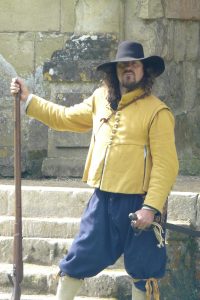 By the mid Seventeenth century the musket was developing as an effective weapon on the battlefield. At this point in their evolution muskets were smooth bore (the barrels did not contain rifle grooves). The muskets are all muzzle loading and in order to learn how to load a fire a musket raw recruits were taught a series of orders, learning step by step. In all there are some 24 orders used to teach recruits how to load a musket and these are laid down in the drill books of the time. On the battlefield this would have been far too complicated, and the orders would have been reduced to “make ready”.
By the mid Seventeenth century the musket was developing as an effective weapon on the battlefield. At this point in their evolution muskets were smooth bore (the barrels did not contain rifle grooves). The muskets are all muzzle loading and in order to learn how to load a fire a musket raw recruits were taught a series of orders, learning step by step. In all there are some 24 orders used to teach recruits how to load a musket and these are laid down in the drill books of the time. On the battlefield this would have been far too complicated, and the orders would have been reduced to “make ready”.
Learn how to load a musket here
The range of the musket would have been in the region of circa 150 yards and the accuracy of the musket was limited to circa 50 yards to hit a human sized target. Even at this range the musket ball would have been able to penetrate armour. To improve the odds various tactics were employed. Musketeers would have been deployed as companies. The companies would operate as a single unit. By firing as single body and at a large opposing body the limitations of accuracy would have been reduced.
Tactics include the use of the Swedish Salvo, developed in the European conflicts. Here the front rank would kneel, the second would stoop and the third would stand over the top. Upon the command of the officer all three ranks would fire at once. Effectively turning the company into a giant shot gun, unleashing a hail storm of lead and a lot of smoke!
Once the musketeers had used all their powder and shot, the musket could be reversed and used as a club in hand-to-hand combat.
The sniper
Typically within a household garrison the estate game keepers/huntsmen would have been employed as snipers. These men would be considered to be the best shots and would be armed with their civilian fowling pieces. These are basically muskets with longer barrels, that improved the accuracy of the bullet. These men would have been sited within towers and tasked with shooting enemy officers